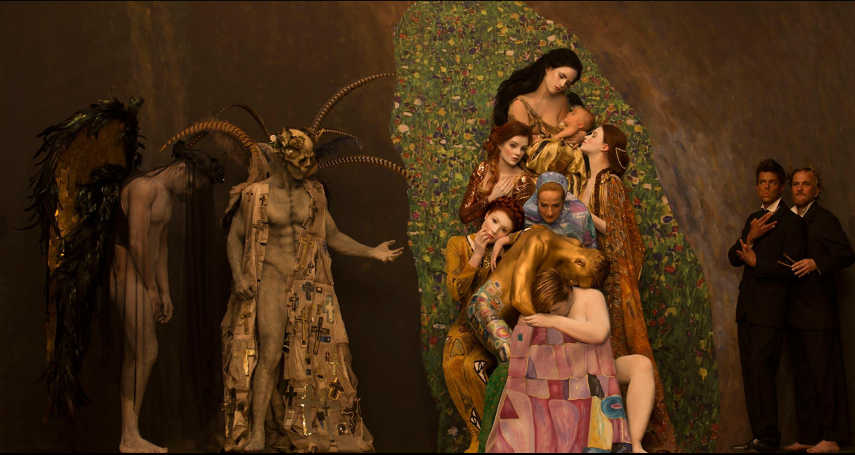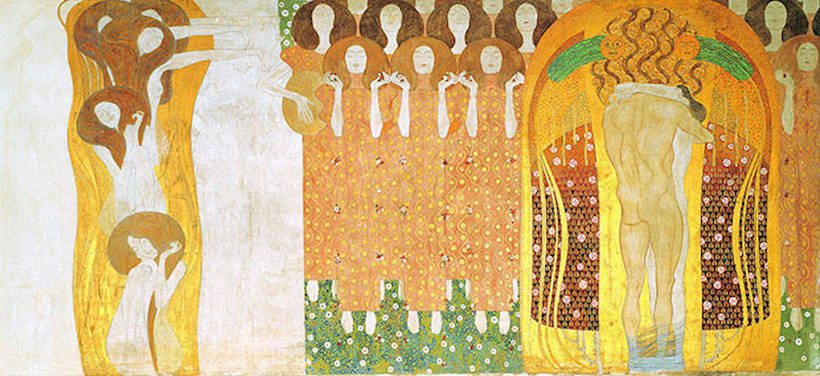After each heartbreaking loss of a musical icon this past year and a half, we have turned to their greatest moments onstage, not necessarily their last, because their final shows weren’t always all that memorable. Declining health, bad recordings… and not every gig is a good one even in the best of times and with the best of performers. But when it comes to John Lennon’s last public appearance, I like to think he might have left the stage exactly the way he wanted to, as a rocker, a provocateur, and a pisstaker in a candy-apple red jumpsuit, backed by a nine-piece miming band of bald men in black leather with masks painted on the back of their heads.
Credited as “John Lennon, Etc.,” the band’s true name, given to them by Lennon himself, is abbreviated on their bass drum: B.O.M.F., or “Brothers of Mother Fuckers.” It was Lennon’s send off to his own career as much as it was a Salute to Sir Lew, as the program was called. Just a few months later Sean was born, and Lennon declared he would retire to raise his son. At the time of his tragic death five years later, he had begun recording again, releasing Double Fantasy and planning a second double album, Milk and Honey. But we never got to see him perform those songs.
The honoree for Lennon’s last gig was Sir Lew Grade, “a powerful media mogul,” notes Dangerous Minds, “with roots in cabaret and variety shows.” A man known as much for his ruthlessness in business as for his Charleston, which he performed on tabletops whenever the mood struck him. In 1969 Grade bought up the rights to over a hundred Lennon and McCartney songs, after some very tense negotiations. Lennon sued Grade in 1974 and settled out of court, and Grade remained the co-publisher of all of his new songs.
As part of the settlement, Lennon recorded his album of covers of classic rock ‘n’ roll songs, appropriately titled Rock ‘n’ Roll. When he appeared at the tribute concert for Sir Lew at the Hilton Hotel in New York—on the bill with Julie Andrews, Tom Jones, and Peter Sellers—he played Little Richard’s “Slippin’ and Slidin,” and Ben E. King’s “Stand by Me” for “a “who’s who of the old Hollywood elite,” including Lauren Bacall, Kirk Douglas, Gene Kelly, and Orson Welles. The show, recorded for TV broadcast, cut his rendition of “Stand by Me” (hear the audio above), but they did air his final song, “Imagine,” which turned out to be the last song he ever sang live onstage (top).
Lennon is in very good form, and seemingly in good spirits. The year previous, he’d scored a number one hit with “Whatever Gets You Thru the Night.” According at least to Paul McCartney and Lennon’s girlfriend May Pang, he had even considered reuniting the Beatles. In November of 1974, Lennon joined Elton John onstage at Madison Square Garden for rollicking versions of “I Saw Her Standing There,” “Lucy in the Sky with Diamonds,” and “Whatever Gets You Thru the Night” on which Elton had played in the studio. You can see a recreation of that performance above. It was technically Lennon’s last live concert appearance.
His final appearance on stage, on the other hand, while it might have been an odd way to say goodbye, whether he meant to do so or not, may not be what we revisit when we revisit Lennon. Why did he agree to do a tribute concert “for a man he had been embroiled in lawsuits with?” With a stage show that many have thought was deliberately designed to antagonize the honoree? We’ll never know. But I’m grateful that his final live song was one that still speaks to us of hope and possibility. Maybe bowing to censors, Lennon changes “Imagine”’s controversial line about religion. Instead, he sings, “Nothing to kill or die for, no immigration, too,” referring both to his troubles with the U.S. immigration authorities and to the borderless world the song projects. “Imagine there’s no countries… Imagine all the people sharing all the world.”
Related Content:
The Night John Lennon & Yoko Ono Jammed with Frank Zappa at the Fillmore East (1971)
John Lennon’s Solo Albums Now Streaming for Free on Spotify
Josh Jones is a writer and musician based in Durham, NC. Follow him at @jdmagness












